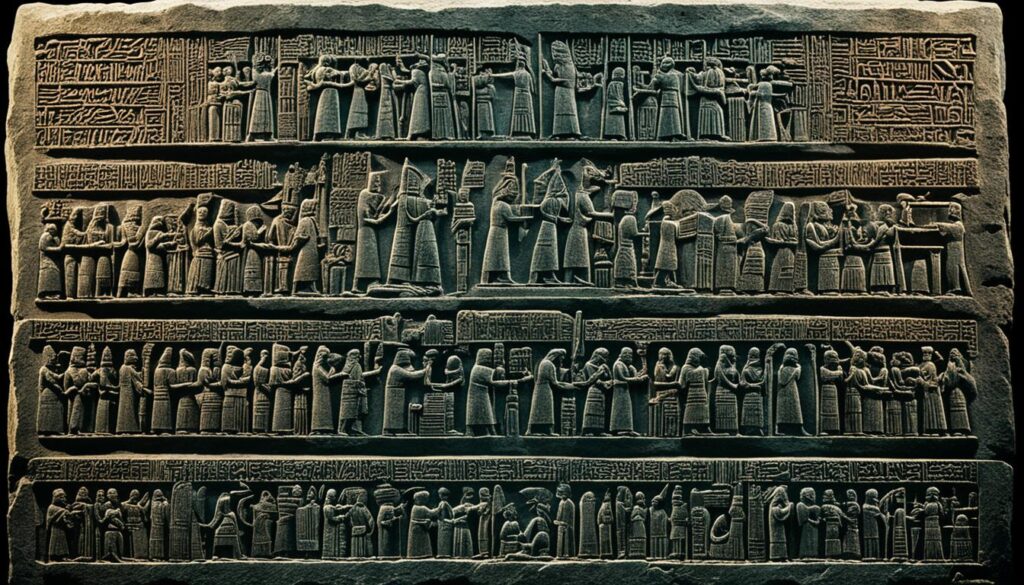In the vast history of Mesopotamia, the Code of Hammurabi shines as a beacon of justice and order. It came from the Babylonian Empire during King Hammurabi’s rule, around 1754-1758 BCE. This set of laws gives us a peek into the social, economic, and legal life of ancient Babylon.
The Code is written on a big stone stele in cuneiform script. It’s one of the oldest and most important legal texts still around today. Found in the 19th century, it has fascinated scholars and historians. It shows us the legal and social setup of Mesopotamia.
The Code of Hammurabi covers trade, family laws, and gender roles. It gives us a detailed look at ancient Babylonian society. Its ideas still affect modern legal systems, showing how its principles have lasted through time.
Uncovering the Origins of Legal Systems
The history of law goes way back to ancient times. People needed rules and laws to keep society in order. The first big change was when laws were written down, moving away from just oral traditions.
In ancient Mesopotamia, like in the Babylonian empire, legal systems started to take shape. The Code of Hammurabi is a key example of written law. It’s one of the oldest known legal codes. Hammurabi, the sixth king of Babylon, played a huge role in making laws clear and organized.
The Birth of Written Law
Before the Code of Hammurabi, laws were passed down by word of mouth. This made them hard to follow and understand. But Hammurabi changed that by writing the laws on stone. This move from oral to written law changed how laws were made and followed, making them clearer and more reliable.
Hammurabi’s Influential Role
Hammurabi made big changes to law and justice in Mesopotamia. He wanted a fair and consistent legal system to keep Babylon stable and just. The Code of Hammurabi was a big step forward. It influenced laws all over the ancient world and helped shape today’s legal systems.
Historical Curiosities: Mesopotamia’s Legal Legacy
The Code of Hammurabi is a key historical find from ancient Babylon. It shows us the deep legal roots of Mesopotamia. This old law book from the 18th century BCE has caught the eye of many scholars. It tells us about the social, economic, and legal life in the Babylonian empire.
The Code of Hammurabi has greatly influenced legal history. It’s full of rules for everything from business deals to criminal justice. This lets us peek into the legal ideas and social norms of ancient Babylon.
Scholars have deeply studied the Code of Hammurabi. They find it full of interesting facts and insights. The detailed inscriptions on a big stone stele show the lasting impact of ancient Babylonian law. Today, it still affects modern legal systems.
The Code of Hammurabi keeps fascinating people who love ancient history. It shows the smart and complex Babylonian legal system. This old law book gives us a lot of information about legal, cultural, and social changes in Mesopotamia.
Deciphering the Code’s Inscriptions
Unraveling Hammurabi’s Code has been a complex and captivating task for scholars and historians. The laws were written in cuneiform on a large stone stele. This was the main writing system of Mesopotamia back then. Understanding these inscriptions needed a deep grasp of Mesopotamian language, culture, and legal history.
The Mesopotamian writing system, cuneiform, was a remarkable invention. It allowed for the recording and preserving of legal, administrative, and literary works. Cuneiform, with its unique wedge-shaped characters, was used all over the region, including for Hammurabi’s Code. Translating these inscriptions was a detailed process. Scholars had to carefully decipher the complex symbols and grammar to understand the laws’ true meaning.
Thanks to their hard work, researchers have uncovered the legal, social, and economic structures of the Babylonian empire. The translation of Hammurabi’s Code has given us deep insights into ancient legal history. It shows us how one of the earliest legal systems worked. Understanding the Mesopotamian writing system and translating these texts has helped us appreciate Hammurabi’s Code’s legacy.

Eye for an Eye: Brutal Justice?
The Code of Hammurabi, an ancient Babylonian legal system, is famous for its “an eye for an eye” rule. This idea of retributive justice, where the punishment matches the crime, has sparked debate. Scholars and ethicists have been discussing it for a long time.
Some punishments in Hammurabi’s Code, like death sentences for certain crimes, might seem harsh today. But, it’s important to see them in the context of ancient Mesopotamia. Back then, keeping society stable and maintaining social order was key.
Understanding Hammurabi’s Punishments
The “an eye for an eye” rule was more than just a symbol of justice. It was a way to keep ancient Babylonian society stable. The law of retaliation made sure punishments matched the crimes. This was meant to stop future crimes and keep the community feeling fair.
But, the use of punishments like the death penalty has raised questions. Some think these punishments were too harsh and unfair, especially when compared to today’s laws.
Despite the debates, Hammurabi’s Code gives us a peek into how legal systems evolved. It shows the challenges of balancing justice in ancient times. Understanding the historical context helps us see the Code’s punishments in a new light.
Hierarchy and Social Order in Babylon
The Babylonian empire had a strict social order, shown in the Code of Hammurabi. This code laid out clear legal rights and duties for everyone, from the nobility to the common workers.
At the top, the king, royal family, and high nobles had the most power. They got the best legal protection and faced lighter punishments. On the other hand, those at the bottom, like slaves, farmers, and artisans, got harsher punishments for the same crimes.
The code also shows how men and women were seen in Babylon. Men had more legal rights and made most of the decisions. But women got some legal protection, especially in owning property and inheriting things. Yet, the laws for men and women were very different, showing Babylon was a male-dominated society.
Learning about the social layers and gender roles in the Code of Hammurabi helps us understand ancient Babylon better. It shows us the detailed legal and social setup of the Babylonian empire. This gives us a clearer picture of life in ancient Mesopotamia.
Regulating Trade and Commerce
The Code of Hammurabi was a set of laws from ancient Babylon. It covered social and criminal laws, but also focused on trade and commerce. This code showed how important economic stability and fairness were in Mesopotamian society.
Economic Principles in the Code
The Code of Hammurabi had rules to protect property, enforce contracts, and standardize weights and measures. These rules were key for Babylon’s trade and commerce to run smoothly. They helped the empire grow rich.
These rules show how the Babylonians knew a stable and fair economy was crucial. By setting laws for trade and commerce, the code helped manage business, solve disputes, and keep the market thriving.
The economic rules in the Code of Hammurabi reveal Babylon’s advanced society and legal system. They give us a peek into the economic laws and trade practices that made Babylon prosperous.

Family Laws and Gender Roles
The Code of Hammurabi is one of the oldest known law sets from ancient Babylon. It gives us a peek into how family life and gender roles were handled back then. This code shows us the social and cultural norms that shaped the lives of people in the ancient world.
The code talks about the legal standing of women, their rights, and duties in families. Even though Babylon was a male-dominated society, the code shows women had some legal protection. This was seen in laws about property, inheritance, and divorce.
The rules on marriage, divorce, and inheritance tell us a lot about family life in ancient Babylon. For example, the code says when a woman could get a divorce and how assets would be split. These rules show women’s legal rights and the need for social order in families.
The Code of Hammurabi also tells us about gender roles in Babylon. Men were seen as the leaders, but women played important roles too. They had legal rights and duties that helped the community.
Learning about the family laws and gender roles in the Code of Hammurabi helps us understand ancient Babylonia better. It shows us the legal and social complexities of life back then. This knowledge helps us see how gender roles and family structures have changed over time.
Influence on Modern Legal Systems
Hammurabi’s Code has had a lasting effect on today’s legal systems. It introduced key ideas like codified law, fair punishment, and legal precedents. These ideas are still important in modern law, even if some of the old laws seem harsh now.
Echoes of Hammurabi’s Code
The Code of Hammurabi has greatly influenced legal history. It brought in ideas like “an eye for an eye” and a central justice system. These ideas have shaped legal systems worldwide, including in the U.S. and other Western countries.
Hammurabi’s Code was a big step towards modern law. It made laws clear and public, which is key to today’s legal systems. It also believed in fair punishment, matching crimes with penalties.
Legal precedents, using past decisions to guide new ones, come from Hammurabi’s Code. This method helps make laws consistent and fair. It’s a key part of how we apply justice today.
Archeological Discoveries and Interpretation
The discovery of the Code of Hammurabi was a big deal in archeology. It’s a large stone with ancient Babylonian laws written on it. Found in 1901 in Susa, it has helped us learn a lot about Mesopotamia’s laws and society.
Experts have studied the cuneiform tablets on the stele a lot. They’ve figured out the laws and rules of Babylonian society. These cover things like trade, family, and even gender roles.
This find has been key to understanding Mesopotamian law. By studying the stele and its texts, researchers have learned about Babylonian laws and their effects. They’ve shown how these laws influenced later legal systems too.






